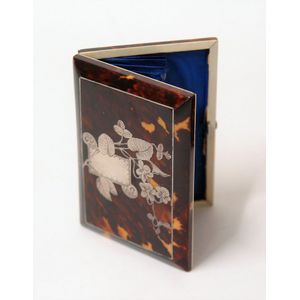Hardstone Inlaid Portable Chest with Intricate Carvings
A hardstone inlaid hardwood portable chest Guanpixiang, 19th/20th century of rectangular form, the hinged domed cover with ruyi head metal fitting lifting to reveal a shallow compartment, above a pair of panelled doors flush within mitred frames opening to reveal two pairs of short drawers above a long drawer, the sides set with bail handles and one side with a chain joining the cover and side, the cover inlaid with a pair of deer beside rocks and trees in varying colours of hardstone including lapis-lazuli, malachite, Mother-of-pearl, and soapstone, the front inlaid with a frieze of bats among clouds and branches of the 'Three Abundancies', the doors with boys at play 31 cm high, 32 cm wide, 23 cm deep
You must be a subscriber, and be logged in to view price and dealer details.
Subscribe Now to view actual auction price for this item
When you subscribe, you have the option of setting the currency in which to display prices to $Au, $US, $NZ or Stg.
This item has been sold, and the description, image and price are for reference purposes only.
- Mother-Of-Pearl - Mother-of-pearl, technical name "nacre", is the inner layer of a sea shell. The iridescent colours and strength of this material were widely used in the nineteenth century as an inlay in jewellery, furniture, (especially papier mache furniture) and musical instruments.
In the early 1900s it was used to make pearl buttons. Mother-of-pearl is a soft material that is easily cut or engraved.
Nowadays it is a by-product of the oyster, freshwater pearl mussel and abalone industries. - Hardstone - Hardstone is not a scientific name for a particular gemstone, but a word used to describe any one or more semi-precious stones used in jewellery and decorative arts, and can include jade, agate, onyx, rock crystal, amber, jet and carnelian. Softer stones and minerals such as soapstone, and alabaster and hard stones used in building such as marble or granite are generally excluded.
- Frieze - An architectural term denoting the flat, shaped or convex horizontal surface of furniture, between the architrave and the cornice, usually found on a cabinet or bookcase, or on desks and tables where it may include drawers, the area between the top and the legs. In ceramics, the term refers to the banding, of usually a repeating pattern, on the rims of plates and vases.
- Malachite - Malachite is bright copper-green coloured stone with concentric layers which displays distinct contrasting veinings. It has been valued in the past for making or decorating small precious objects such as clocks, jewellery, dishes and so. In the Orient it was used for snuff bottles and in Russia and was favoured by the Faberge workshop. larger pieces were used for table tops.
The principal source of supply was Russia but it is to be found in other regions such as Southern Africa, Mexico, Australia and France.
Malachite glass is a manufactured material that was intended to resemble malachite, but often bears more resemblance to a veined coloured marble due to its lower gloss finish and lack of concentric layers. Malachite glass was manufactured by many glassworks in the 19th century including Loetz in Austria and others in Bohemia and Davidson's Greener's and Sowerby in north eastern England.
It was particularly used for scent bottles, bowls, and small vases often decorated with nymphs.
Malachite glass has been manufactured continuously since the late nineteenth century, most is unmarked and it is difficult to distinguish the age or manufacturer of most commercial pieces.
This item has been included into following indexes:
Visually similar items

Fine antique silver bound and inlaid ebony casket, with swing carry handle, 15.5 cm long
Sold by
in
for
You can display prices in $Au, $US, $NZ or Stg.

A Victorian tortoiseshell inlaid card case, the silver inlay with rectangular vacant cartouche and floral and leaf framing, the watered silk and sectional interior with ivory trim. 10.8 x 7.8 cm
Sold by
in
for
You can display prices in $Au, $US, $NZ or Stg.

Antique French trunk, has key, approx 45 cm high, 71 cm wide, 43 cm deep
Sold by
in
for
You can display prices in $Au, $US, $NZ or Stg.

Chinese carved shoushan stone seal 4.7 cm high
Sold by
in
for
You can display prices in $Au, $US, $NZ or Stg.
